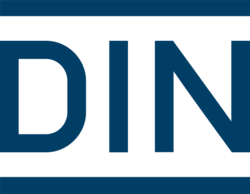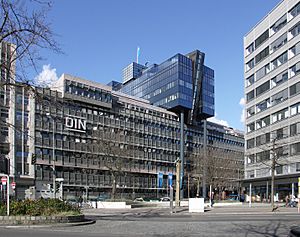Deutsches Institut für Normung facts for kids
 |
|
 |
|
| Types | nonprofit organization |
|---|---|
| Legal status | registered association |
| Headquarters | Berlin |
| Country | Germany |
| Membership | 3,518 (2022) |
The Deutsches Institut für Normung e.V. (DIN), also known as the German Institute for Standardisation in English, is a special organization in Germany. It is a non-profit group that creates and manages standards. Standards are like rules or guidelines that help make sure products, services, and processes work well and are safe.
DIN is the official group that represents Germany in the ISO. The ISO is a worldwide organization that creates international standards. DIN's main office is in Berlin. There are about 30,000 DIN standards. These standards cover almost every area of technology and daily life.
Contents
History of DIN
How DIN Started
DIN was founded in 1917. Back then, it was called the Normenausschuß der deutschen Industrie (NADI). This means "Standardisation Committee of German Industry." At first, it focused only on rules for industrial products.
Name Changes Over Time
In 1926, the organization changed its name. It became the Deutscher Normenausschuß (DNA). This means "German Standardisation Committee." The name changed because they started working on standards for many different areas, not just industry.
Then, in 1975, it changed its name again to Deutsches Institut für Normung, or 'DIN'. The German government officially recognized DIN as the national standards body. This means DIN represents Germany's interests in creating standards both in Europe and around the world.
Understanding the Name 'DIN'
Many people mistakenly think 'DIN' stands for Deutsche Industrienorm ("German Industry Standard"). This is because of the organization's first name, NADI. NADI used to publish its standards as DI-Norm. For example, the very first standard published in 1918 was 'DI-Norm 1'. It was about tapered pins. Even today, some people still connect DIN with this old name.
Famous DIN Standards
One of the oldest and most well-known DIN standards is DIN 476. This standard introduced the A-series paper sizes in 1922. These are the paper sizes we use today, like A4 paper. In 1975, this standard was adopted internationally as ISO 216.
Other common examples of DIN standards in modern technology include DIN and mini-DIN connectors for electronics. The DIN rail is another example.
In 2020, DIN published DIN SPEC 3105. This was the first German standard to be released under an open license (CC-BY-SA 4.0). This means people can use and share it more freely. It was created to make the standardization process more open.
How DIN is Organized
DIN is set up as a non-profit organization under German law. This means it doesn't aim to make money for owners.
DIN owns a company called DIN Solutions GmbH. This company creates the content for the DIN standards. It also owns DIN Media (which used to be called Beuth Verlag). This company sells the manuals and documents for DIN standards. DIN also has shares in DIN Bauportal GmbH and DQS Holding GmbH.
How DIN Standards are Named
The name of a DIN standard tells you where it comes from. Here's what the different parts mean:
- DIN #: This is used for German standards that are mainly important within Germany. They might also be a first step towards becoming international standards.
- E DIN # means it's a draft standard (still being worked on).
- DIN V # means it's a preliminary standard (not final yet).
- DIN EN #: This means it's the German version of a European standard.
- DIN ISO #: This means it's the German version of an ISO standard.
- DIN EN ISO #: This is used when a standard has been adopted as both a European standard and an ISO standard.
Some DIN standards have a long history. For example, DIN 5009 describes the German Phonetic spelling code. This standard was updated in 2022. The new version uses city names instead of person names for the letters.
Examples of DIN Standards
Here are some examples of important DIN standards:
- DIN 476: This standard is about international paper sizes. It is now known as ISO 216 or DIN EN ISO 216.
- DIN 1451: This is a specific typeface (font) used by German railways and on traffic signs.
- DIN 31635: This standard describes how to write Arabic language words using the Latin alphabet.
- DIN 41612: This is a mechanical standard for electrical connections on backplanes (parts of computers).
- DIN 72552: This standard defines the numbers for electric terminals in automobiles.
Getting Access to Standards
DIN standards are not free for everyone to access. DIN sells subscriptions and descriptions of its standards through its companies, DIN Solutions GmbH and DIN Media.
However, there was a special case for four EN standards. These were available as DIN-EN standards for a fee from DIN Media GmbH. In March 2024, the European Court of Justice (ECJ) made a decision. They said that these specific standards must be made available for free. This is because these standards are part of European Union law.
Criticisms of DIN
Some people have concerns about how DIN creates its standards. They say the process is not always clear or "transparent." Most of the committees that create standards are made up of people from companies that will be affected by those standards. DIN does not usually share the names of these committee members.
In 2023, the Federal Ministry for Housing, Urban Development and Building in Germany started looking into DIN standards. They wanted to see if these standards were making building costs too high. The goal was to make planning and building faster and cheaper. This would help create more affordable homes. The ministry said they were reviewing the building standards.
See also
 In Spanish: Deutsches Institut für Normung para niños
In Spanish: Deutsches Institut für Normung para niños
- Austrian Standards International
- Swiss Association for Standardization
- Die Brücke, an earlier German institute that also worked on paper sizes
- DIN film speed
- DIN connector
- Scuba DIN connection
- Scuba DIN connectors
- DQS - Deutsche Gesellschaft zur Zertifizierung von Managementsystemen, a company partly owned by DIN
- DGQ - Deutsche Gesellschaft für Qualität, founded in 1985 with DIN
- List of DIN standards

